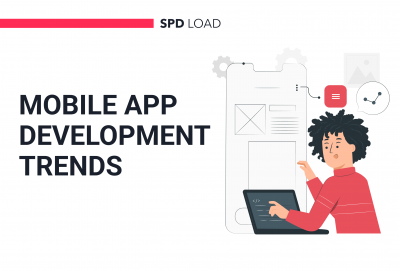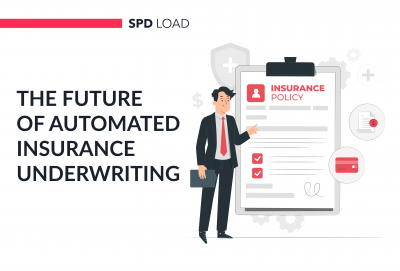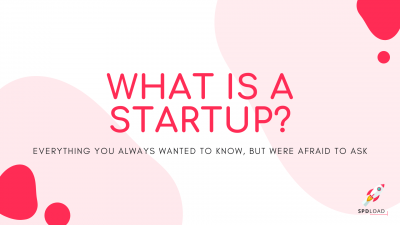How to Build Your Own eLearning Platform: A Step-by-Step Guide
- Updated: Nov 12, 2024
- 12 min
With widespread school and college closures, students rely heavily on e-learning platforms to advance their education. Companies are also turning to e-learning technologies to effectively train employees.
According to Global Market Insights, the e-learning industry is booming and expected to hit $300 billion soon.
But how does one build a high-quality e-learning platform to meet this growing demand? What features and functionalities do modern learners expect? And how much does an intuitive, user-friendly e-learning website cost to develop?
In this blog post, we’ll explore how to build your own e-learning platform to capitalize on this accelerated growth in online education.
Ready to enter the education tech field? Here are EdTech startup ideas to explore the market.
Unlock your startup potential now — start transforming your vision into a scalable solution with our expert developers today!
Why Create Your Own eLearning Platform?
Before we move on to how to create an e-learning website, let’s understand why to build it.
E-learning is transforming everybody, whether they are students, employees, content creators, or teachers.
Also, with your e-learning website, you can unify all these segments.
Europe stands to gain the most from the virtual learning scenario. In 2019, Europe had 35% of the market share, and still, it is growing.
Here are some important reasons to build an e-learning website:
- Online education is a lucrative industry. Once you establish your brand, you can only expect exponential usage. Hence, creating an engaging and smart platform is the priority.
- Students also heavily rely on the internet to educate themselves. Due to this, if they get access to a dedicated platform for their studies, it will be profitable.
- Online learning has grown significantly in formal education and is now becoming important in other fields. The corporate e-learning industry grew by 900% between 2001 and 2017. In this case, we need to build an all-encompassing website for virtual learning.
- Companies that create an e-learning website for their employees observe better productivity. This also reduces the training by 30% to 40% as per a Brandon Hall Research.
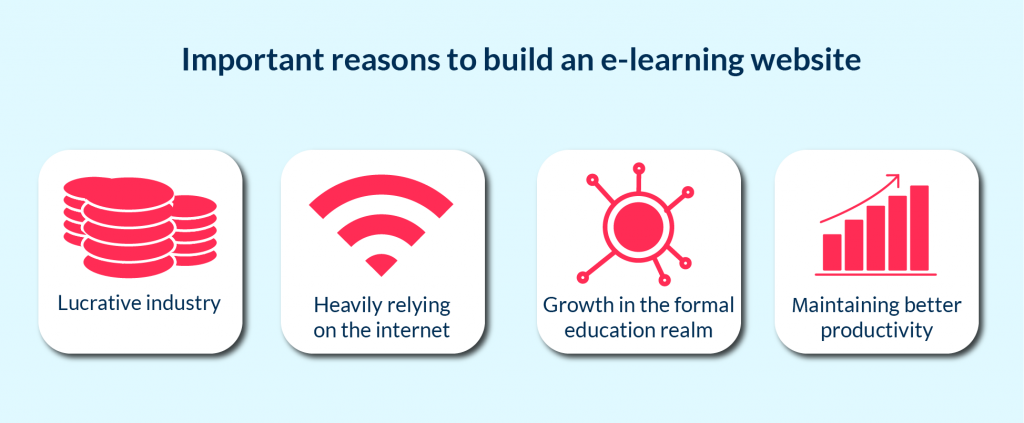
Types of Online Learning Platforms
Before we understand how to create an e-learning platform, let us decide which platforms are there. online learning platforms are split into two major domains.
Synchronous and Asynchronous learning. Apart from these two major systems, we need to identify the other subtypes of platforms.
| Type of Platform | Description | Examples |
| Learning Destination Sites | These e-learning websites are like online storefronts. Different users and content providers can list their courses and training material. They can also build it on the website with a Learning Management System.
Users can select and access the required course. These courses may either have a redirect link or a comprehensive course available on the website. Generally, the websites host the courses by content creators and also manage the payment systems. |
|
| Traditional Learning Management Systems | If you want to create e-learning website that offers tools to the content creators, go for TLMS. Apart from creating the courses, users can do various other tasks.
This includes generating reports, tracking the student’s progress, and creating profiles. The companies or institutions must know how to create TLMS-based online learning platforms for internal training. You can also extend it further to entertain outside audiences. They help employees with different kinds of programs. It can be anything from managing daily tasks optimally to filing tax returns. |
|
| Open Source-learning Management System | Open source means that these platforms are free to use for the users. You can build e-learning website on these lines if you want to increase your user engagement.
The benefit is that you can allow content creators to create their courses and host them on the platform. However, there are customization experts that can help the creators modify the courses. They will help make the course more user-friendly and interactive. These experts will charge a fee for helping the content creators, which becomes a revenue model. |
|
| Modern Learning Management Solutions | Modern LMS means that you create e-learning website addressing specific topics and pedagogies. These systems have better scope for targeting than others.
The users coming to this kind of online learning platform will be specific. Thus, content creators can also be from specific domains. You can provide them with resources about how to create an effective course for their users. |
|
| Learning Management Ecosystems | A good example of such a system is the NeXus Platform, run by the University of Notre Dame.
With an open-source LMS at its foundation, the NeXus platform integrates all the other features. This includes reports generation, checking, eCommerce stores, and others. The creation of this comprehensive platform is also complex. Such an e-learning website will need a strong backend server and constant monitoring. You need to build a strong and loyal customer to stay in business. Learn more about effective LMS implementation strategies. |
|
| Tailor-Made-learning Platform | Tailor-made means you can embed a mix of features.
Hence, before you know how to create e-learning web app gather all the best features of different platforms. A custom-made website that can create a custom user experience is something that is one of the most beneficial options. Based on the market research, you can create a platform that offers several features. This e-learning website can involve pedagogical learning and reporting systems. Further, you can include aspects like LMS, course creation, and much more. Apart from the most proactive features, you must also work on User Experience. An easy-to-use platform powered by a good UX will increase engagement and interaction with the platform. |
|
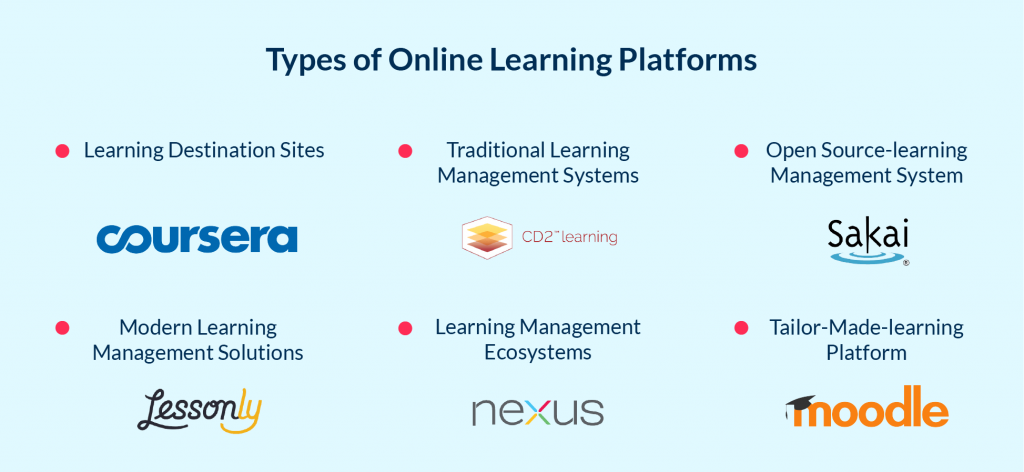
Making Money with Online Learning Platforms
As important as it is to create e-learning web product that gains traction. It is imperative to understand how to generate revenue.
This is something that goes beyond thinking I have an app idea.
Also, you must know how to create an online learning platform that resonates with your idea.
There can be a mix of monetization strategies for every type of learning platform.
To ensure a high ROI, it is essential to utilize a mix of earning strategies. Even if you want to create an open-source LMS, you can effectuate an appropriate revenue generation model.
Here are a couple of monetization models that you can follow:
| Monetization Model | Description |
| Subscriptions: | A good method is associating with universities or a group of institutions.
Allow them to use your e-learning web app by enlisting courses prepared by the institution. Add some tutorials about how to create courses. The students can get training from the online lectures. |
| Freemium Method | As a startup, the freemium model is the most appropriate for you. This will help expand your business and generate free marketing.
Freemium means you can provide some services for free, but the certificates are paid. Online course platform edX works on a similar model. They provide free course material. But, the certificates to ensure completion of the course are paid. |
| Online Advertisements | This is a common revenue generation method when you create e-learning website. Plus, advertisements can bring a constant stream of revenue. |
| Marketplace | If you build e-learning website and enlist courses on it for others to buy, it becomes a marketplace. Revenue can come from the commissions you can earn from seller’s sales. |
Must-Have Features for an MVP
Next up, in creating an online learning platform, features and functions are integrated.
Which are those features that can get you instant success in the e-learning marketplace? If you want to create a successful platform, the below-listed features are essential for the website.
| Feature | Description |
| Login and Authentication | This is a common step for both the students and the trainers.
Creating a secure registration sequence for the online learning platform is a must. Users should know how to create their profiles and set their preferences. For trainers, allow them to enter their credentials and other information. Protecting student privacy is more than just a legal requirement, it’s about trust and responsibility. Learn what is FERPA compliance and how it helps institutions uphold these values. |
| Searching Options | Any student or teacher must be able to find their relevant course.
Build a catalog of courses on the e-learning website. Let the students create their favorite course lists. |
| Dashboard | Building a student and teacher dashboard will help the respective users get easy access.
They will get all the information in a single window. This will also help you increase engagement and interact with the users. Also, it can provide users with recommendations and suggest areas for improvement. |
| Smart Reporting and Analytics | Students will want to know their key improvement areas. Thereby, while you create e-learning website, include smart technologies.
Leveraging the student’s course data allows the AI to create personalized recommendations and tips. See the numbers behind the AI revolution in our latest article on AI statistics. These will help a student narrow down their key focus areas. |
| Information Management Systems | You can also add IMS for students and teachers.
It will help them take an overview of their previous activity on an online learning platform. Due to this, teachers can know how to create further courses. They can understand which courses are getting traction and which are not. |
| Gamification | Gamification assists in two ways. It makes learning fun and creates an impact on the user. Mostly, gamification is useful for students.
So, you need to build your e-learning website which gamifies the student’s progression to the next levels. Along with this, include animations for scores, and let them create their avatar and background, among others. It is also estimated that gamification in learning will be worth $1.5 billion. So, it is essential to add such functions when you build an e-learning website. |
| Add Video Content | Forrester Research’s results found that the employees consider video courses time-saving.
Even the students would understand better from videos rather than reading notes and books. |
| Course Creation | Allow private teachers and institutions to create courses for your e-learning website.
Allowing the teachers to sell their courses can also become a revenue-generation model for your e-learning website. |
| Payment Systems | Lastly, it is also essential to add all kinds of payment systems to the e-learning platform.
The greater the payment options, the easier it will be for the users to interact with and use your website. |
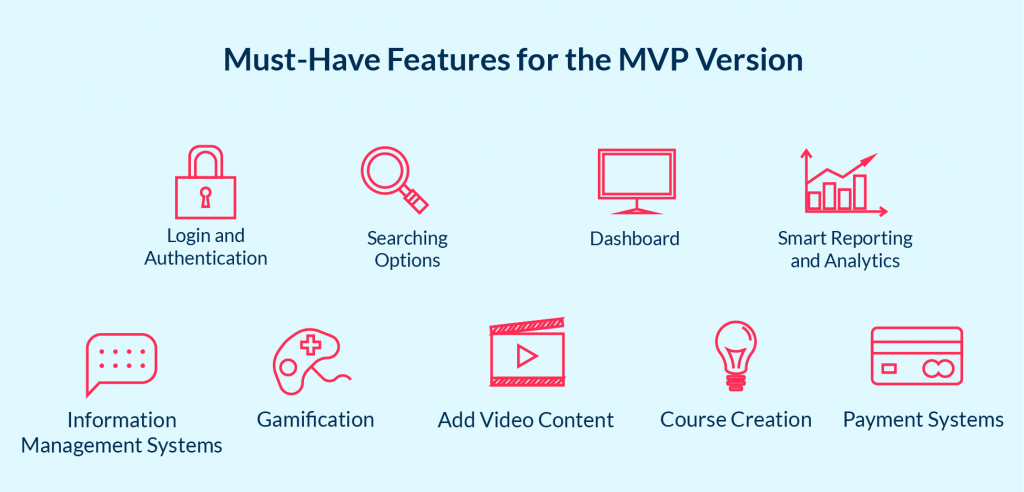
How to Build an eLearning Website
Moving ahead in how to create an e-learning web app or website, we will discuss the building process.
Let’s start with the workflow, and then we will move on to team composition, tech stack, and the challenges.
1. Come Up with an Idea
| Step | Description | What to do? |
| Ideation | It all begins with an idea. Once you have the seed, nurture it with additional information, and try to build a working solution with it.
Make sure to conduct market research and what is the pain factor that your e-learning website will solve. |
|
| Understand your Audience | You must understand your target audience.
If you can relate with the audience better, your solution will be more traction. Understand its applicability. In which areas do you need to improve from your competitors? Answering such questions will help you create a promising online learning platform. The next aspect is how to capture your audience. |
|
2. Research the Project Details
| Step | Description | What to do? |
| Market research | You need to research and streamline your solution on the basis of your project. Apart from the audience research, understand the market.
Analyze which platforms are working well and which are facing stagnant growth. Good research matters as it helps fill a void in the market. Ed tech startups like Openclassroom curate specific courses. It helps people get training in those fields which have a high demand in the market. On the other hand, another platform, KNO was successful in raising $73 million capital. Afterward, the project saw failure due to the lack of proper market research. Hence, investing time, strategizing, and capitalizing on good ideas and research is essential. |
|
| Competitors research | After initial research of the market, you should make a list of closest competitors. It helps to identify and systemize first to-do steps.
Understanding of competitors landscape helps founders to generate the core features, find out unique market positioning and focus on the to-go-on-market strategy to beat the niche. |
|
3. Design and Development
| Step | Description | What to do? |
| Prototyping | A captivating UX is the next important aspect of the workflow. You must create an e-learning MVP that engages with the users. Learn more about how much does it cost to build an MVP.
Make sure that it is easy to use. The users can understand how to navigate through the website easily. |
|
| UI Design | A catchy UI is also an important part of making users’ interactions smooth and engaging.
Also, it is important to develop a nice design system to build a strong brand, memorable brand voice, typography and colors. |
|
| Development | At this stage the development team of your e-learning solution starts to implement the business logic and key features into a workable product.
The prototypes become the real website with real data and interactions between the user and the system. |
The elearning app development includes many different stages. Let’s highlight some of them:
|
| Testing & Debugging | At this stage, the QA team checks out each screen and each interaction to make sure that everything works as it is supposed to. |
|
4. Choosing a Tech Stack
| Type of work | Technology |
| Frontend | React, React Native |
| Backend | Node.JS |
| Database management | MySQL, Mongo DB |
| Service provider | AWS |
5. Assemble a Development Team
You must employ a proactive development team for this process. They should have experience and understand the nuances of the industry.
Online learning is a highly competitive market. You must know how to create an online learning platform that solves a problem.
It must also have a fluid design and responsiveness. The creators, designers, and developers of your website will help make a difference.
So, here is a list of the professionals you can employ for the process.
- 1 Front End Developer
- 2 Back End Developers
- 1 Project Manager
- 1 Business Analyst
- 1 UI/UX Designer
Challenges of Building an Online Learning Platform
1. Staying Motivated
Even if you have the best online courses on your platform, you may face a lack of engagement. Users are less motivated to visit the platforms individually.
In the sphere of community learning, this issue is prevalent all over the industry. However, embedding gamification features can help enhance that urge to interact.
2. Choosing a Learning Model
When educators try to build an e-learning website, choosing the appropriate model is imperative.
Different types of online learning platforms have separate development models. Hence, it becomes important to choose one. You need to filter down to one type, before understanding how to create it.
From concept to creation – launch your marketplace with SPDLoad!
Budgeting for an eLearning Platform Build
To build e-learning website, you need the assistance of a team. You can opt for one out of three employment models.
- Hire your own team (in-house).
- Hire a Local Agency.
- Outsource the work.
The total cost to create e-learning website will depend on several factors. First is the per hour prices your team charges.
For instance, if you choose to outsource mobile app development, Ukrainian developers charge on average $40 per hour. It will take somewhere between 1100 to 1500 hours to create the desired e-learning web app.
With this in mind, the total development cost can be somewhere around $60,000 to $150,000, but this is just an approximate number and can vary depending on multiple factors such as app complexity, location of your development partner, tech stack, etc.
Making the right choice is crucial. Here’s everything you need to know about in-house development vs. outsourcing.
Ready to Build Your Own Platform?
Building a custom eLearning platform is an ambitious yet rewarding goal if done right. This guide outlined steps for creating your own tailored online learning solution.
While you now have a solid development roadmap, undertaking a major platform build has challenges. If tackling the technical aspects seems daunting, leverage eLearning specialists.
Our consulting services provide end-to-end guidance, from shaping ideas to delivering an optimized platform. You can confidently create a reality-ready solution by tapping into our team’s years of experience building award-winning eLearning products.
Reach out for a free consultation today to make your online education vision a technical success story with expert support!



